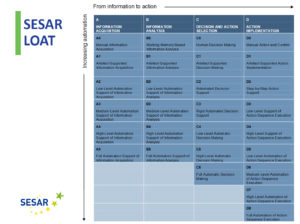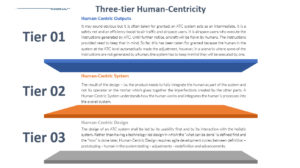There should be little doubt or argument that the journey towards further automation in Air Traffic Control is well on its way and is set to continue. Also, there is little doubt that many of the future solutions will have, at least, some of their components based on Artificial Intelligence techniques.
If we look at SESAR´s Level of Automation Taxonomy (LOAT) model as displayed below,

most modern ATC Systems are somewhere between B4/B5: High level – full automation support of information analysis and C1: Artefact-supported Decision Making.
The end goal for most R&D projects is to arrive to D8: Full automation of action sequence execution for all ATC tasks.
This raises a few items to consider and this is what we at Ingenav think about this:
- Until D8 is reached on all ATC tasks (whether it will be desirable for it to be reached is the subject of item 2), humans will be part of the system and the system will need to be Human-Centric.
- It is questionable whether, even if technologically possible, it would be desirable to reach D8 and have a non-human-in-the-system ATC chain.
Developing these items, a little further we need to consider:
- A three-tier Human-Centric approach is necessary:
Human-Centricity needs to be seen holistically:
The design of an ATC system needs to be done through a human-centric approach. The result, i.e. the ATC system itself needs to be human-centric. And with the growing autonomy coming about, one shall not forget that the end-user of ATC is not the air traffic controller but the airspace user: the human who flies the aircraft. These are the three tiers – from the design, to the product itself, to its output.

Starting from Tier 3: Human-Centric design:
The design of an ATC system shall be led by its usability and by its interaction with the holistic system first. Rather than having a technology-led design in which the “what can be done” is defined first and the “how” is done later, human-centric design requires agile development cycles between definition – prototyping – human in the system testing – adjustments – redefinition and advancements. The design team needs to incorporate from a very early stage operational expertise that understands the business and the process and that co-lead the design. This should be the case even when the functionalities that are being developed would be in the high Ds in accordance with LOAT as these will always interact with other processes where the human is involved.
Tier 2: Human-Centric system:
The result of the design – i.e. the product, needs to fully integrate the human as part of the system and not its operator or the mortar which glues together the imperfections created by the other parts. A Human-Centric system understands how the human works and integrates the human´s processes into the overall system. Principles such as relevance, timeliness, prioritized and rationalized for human understanding should be key in all the interactions of a human-centric system.
Tier 1: Human-Centric outputs:
It may sound obvious but it is often taken for granted: an ATC system acts as an intermediate; it is a safety net and an efficiency boost to air traffic and airspace users (that is the objective of ATC!). It is airspace users who execute the instructions generated by ATC. Until further notice, aircraft will be flown by humans. The instructions provided by ATC need to keep that in mind. So far, this has been taken for granted because the human-in-the-system at the ATC level automatically made the adjustment. However, in a scenario where some of the instructions are not generated by a human, the system has to keep in mind they will be executed by one.
It is important to insist on Human-Centricity and the human-in-the-system principle and not to see the human as an external agent who acts as an operator or a mediator, or even worse as a corrector of imperfections. It is important to take the learnings we have made in the past decades and build on them rather than to try to discard them because we believe that advanced automation will make the human somehow less important.
Question 2: is it desirable to arrive to D8?
The quick answer to this is that we don´t know. To date, we do not have the maturity to understand what a fully autonomous system, which in turn is an intermediate between vigilance and execution, would mean. The gap to get there is still too big and we need to narrow this gap in order to understand better the ramifications. Of the ramifications, we are able to identify to date one can include resilience, of such a system and degraded modes, interconnectiblity, responsibility, certification, the holistic concept of operations of the airspace user and societal (is it, in fact, desirable and productive from a societal perspective to try to eliminate the human from the system?).
R&D in this area must continue and needs to be holistic and not just technology-driven. We can do a lot of things but should we apply them? By continuing R&D, the sector will mature further and whilst bridging the gap, we will also understand the opportunities and the threats that such changes would bring. If we ever reach D8, it should be an evolution and not a revolution.
Conclusion
Undoubtedly, work is in progress towards advanced automation in the lines of decision-making support and basic autonomous execution of tasks. Human-Centricity is primordial in the development of such tools and this human-centricity needs to be taken care of in 3-tiers: at design, at the system and at output levels. Achieving D8: full automation of task execution for all tasks making up ATC should be an R&D goal and not an operational one at this stage. The gap between the current paradigm and that one is too wide and we do not have the maturity to understand the ramifications of such a change. R&D needs to be holistic and not just technology-driven. A stepwise approach towards understanding will be necessary.
PS Ingenav is currently participating in a project with a Core European ANSP and ATC system manufacturer to introduce Decision Support Operational ATC tools using amongst other historical data and machine learning principles. In this project, a 3-tier Human-Centric approach is being applied.